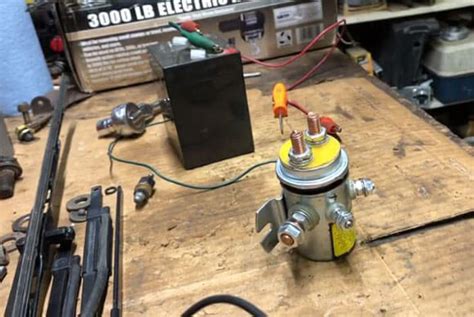How To Test A Winch Solenoid
Ronan Farrow
Mar 26, 2025 · 3 min read

Table of Contents
How to Test a Winch Solenoid: A Comprehensive Guide
Winches are invaluable tools for off-road enthusiasts, recovery professionals, and anyone needing heavy-duty pulling power. However, a malfunctioning winch solenoid can quickly bring your operations to a standstill. This guide will walk you through how to test a winch solenoid, saving you time, money, and frustration.
Understanding the Winch Solenoid
Before diving into testing, let's understand the solenoid's role. The solenoid acts as an electromagnetic switch, controlling the high-amperage current flow to the winch motor. When you engage the winch, the solenoid activates, connecting the battery power to the motor. A faulty solenoid prevents the winch from functioning correctly.
Common Signs of a Bad Solenoid
Several symptoms indicate a potential problem with your winch solenoid:
- Winch won't engage: This is the most obvious sign. The solenoid isn't completing the circuit to power the motor.
- Clicking sound: You might hear a faint clicking sound when activating the winch, indicating the solenoid is trying to engage but failing.
- Overheating: Excessive heat around the solenoid suggests internal resistance or short circuits.
- Intermittent operation: The winch might work sometimes but not others, indicating inconsistent electrical contact.
Testing Your Winch Solenoid: A Step-by-Step Approach
Testing your winch solenoid requires some basic tools and safety precautions. Always disconnect the battery's negative terminal before starting any electrical work. This prevents accidental shorts and potential injuries.
Tools You'll Need:
- Multimeter: A digital multimeter is essential for checking voltage and continuity.
- Test leads: These connect the multimeter to the solenoid terminals.
- Wire brush: This helps clean any corrosion from the solenoid terminals.
- Gloves: Safety first!
Testing Procedure:
-
Visual Inspection: Begin by visually inspecting the solenoid for any obvious damage, such as burnt wires, loose connections, or physical cracks. Clean any corrosion from the terminals with a wire brush.
-
Check the Power Supply: Use your multimeter to check the voltage at the battery terminals. It should read approximately 12V (for a 12V system) or 24V (for a 24V system). This confirms a healthy battery providing sufficient power.
-
Continuity Test: Set your multimeter to the continuity setting (usually represented by a diode symbol). Touch the test leads to the large power terminals on the solenoid (the two thickest posts). A continuous tone or low resistance reading indicates a good connection between these terminals. A lack of continuity suggests an internal failure within the solenoid.
-
Coil Test: Next, find the smaller terminals on the solenoid (these are usually wired to the switch). Set the multimeter to resistance mode (Ohms). Measure the resistance across these smaller terminals. You should get a reading, although the exact value depends on the specific solenoid. A reading of infinity (OL) suggests an open circuit within the solenoid's coil.
-
Voltage Drop Test (Advanced): If the continuity and coil tests are fine, but the winch still doesn't function, perform a voltage drop test. Connect the multimeter to the smaller terminals while activating the winch. A significant voltage drop indicates a problem with the solenoid’s ability to switch the high amperage current, potentially needing replacement despite passing the other tests. A small drop is normal.
Interpreting the Results
- Continuity test fails: The solenoid needs replacement.
- Coil test fails: The solenoid needs replacement.
- Voltage drop test shows significant voltage drop: The solenoid may be failing or there is another problem in the circuit, such as corroded wiring.
Remember, if you're unsure about any step, consult a qualified mechanic or winch specialist.
Preventing Future Solenoid Problems
Proper maintenance is key to prolonging the life of your winch and solenoid:
- Keep terminals clean: Regularly clean and lubricate the terminals to prevent corrosion.
- Use appropriate gauge wiring: Insufficient wiring can overheat the solenoid.
- Don't overload the winch: Avoid exceeding the winch's rated capacity.
- Regular inspections: Inspect the solenoid and wiring regularly for any damage.
By following these steps and taking preventative measures, you can keep your winch operating smoothly for years to come. A properly functioning winch solenoid ensures reliable performance when you need it most.
Featured Posts
Also read the following articles
| Article Title | Date |
|---|---|
| 6 Of Pentacles How Someone Feels About You | Mar 26, 2025 |
| How To Start A Title Company In Texas | Mar 26, 2025 |
| How To Write A Reference Letter For Citizenship | Mar 26, 2025 |
| The How I Survived Game | Mar 26, 2025 |
| Kerastase Initialiste How To Use | Mar 26, 2025 |
Latest Posts
Thank you for visiting our website which covers about How To Test A Winch Solenoid . We hope the information provided has been useful to you. Feel free to contact us if you have any questions or need further assistance. See you next time and don't miss to bookmark.
